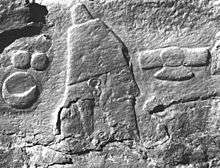Shikaft-e Gulgul
Shikaft-e Gulgul (or Gulgulcave) site is an Assyrian rock relief and inscription located in the vicinity of Gulgul, a village near Mount Pushta-e Kuh at Ilam in Iran. It was discovered by Louis Vanden Berghe (Ghent University, Royal Museums of Art and History, Brussels). It is a relief carved into the rock, attributed to Esarhaddon. The sovereign is wearing a tiara Assyrian, dressed in a tunic leaving only the feet appear, and wears earrings. It is armed with a sword worn on the belt, and holding a mace in his left hand. The right arm is broken, and seems to mouth an object. On both sides of the king, are represented divine symbols. They include left a full moon, the seven planets and the sun disk symbol Ishtar. At right, a winged disk, and a horned tiara are identified as symbols of Shamash and Assyria. An inscription is also visible.

See also
- Bit-Istar
- Tang-i Var
References
Reade, J.E. 1977. Shikaft-i Gulgul: its date and symbolism. Iranica Antiqua 12: 33-44. Leiden
Vanden Berghe, L., 1984 Reliefs rupestres de l’Iran ancien, musée royaux d’art et d’histoire, Bruxelles, 208pp.
Coordinates: 33°29′28″N 47°27′40″E / 33.49111°N 47.46111°E